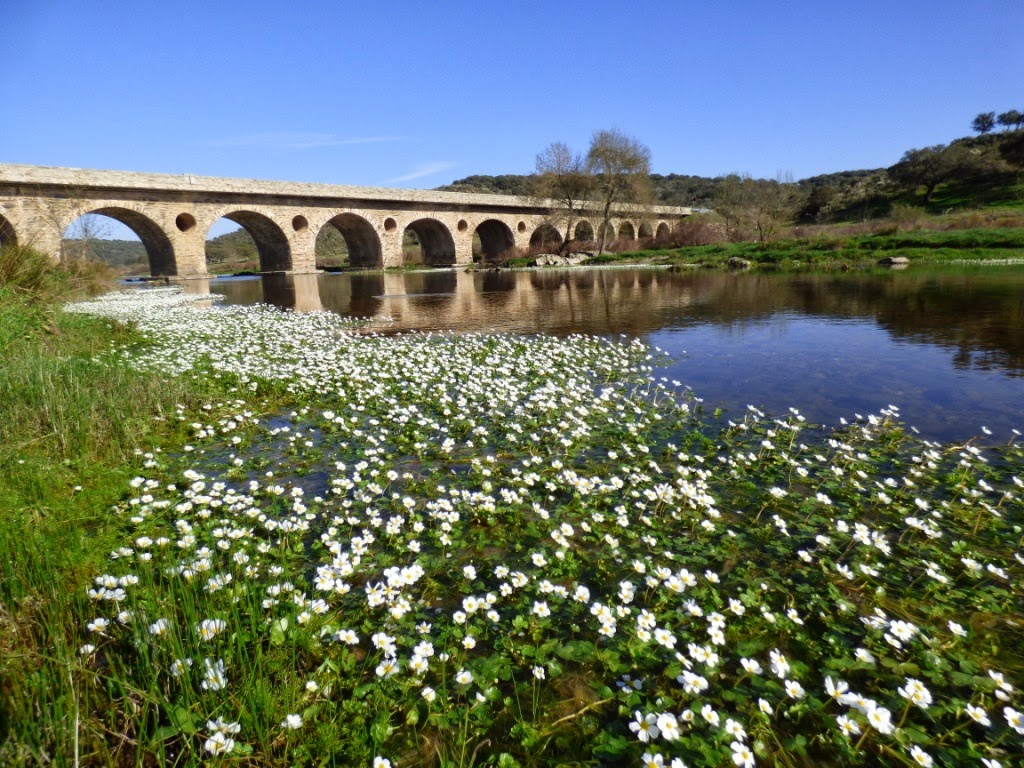 |
| River Almonte early spring (Martin Kelsey) |
There is unanimity, even amongst those of my neighbours who are shepherds or casual farm workers and can normally be relied upon, by default, to have some issue with the weather, that this spring has been a wonder so far. Until the last couple of days of fresh northerly winds, our recompense for the rain and gales that challenged all of us during the late winter has been an intensity of green in the landscape, set off against blue skies, sunshine and touches of warmth. The countryside has been a jewel, as the photo of my beloved Almonte shows, with the swathes of water crowfoot bordering the mirror-like river.
The sequence of spring colours has commenced, the yellows dominating the pastures, with marigolds and crucifers forming a sheen across the meadows, set off with the vivid splashes of Hoop Petticoat Narcissus, usually like a shower of bright sunny yellow, but sometimes too in the densest of groups, like a fanfare of trumpets.
 |
| Hoop Petticoat Narcissus (Martin Kelsey) |
Walks across the countryside now in Extremadura become even more multi-dimensional, alert for butterflies, spotting orchids, ears tuned in for calls and songs of newly arrived migrants, searching the skies for incoming Booted Eagles and Montagu's Harriers. The early migrants have now become well established with the breeding season underway for birds like Lesser Kestrel, and the industrious House Martins and swallows, flocking around the muddy sides of puddles to collect nest material.
 |
| Lesser Kestrel (Martin Kelsey) |
And meanwhile resident species are even further advanced in their breeding cycle, birds like Griffon Vultures with young in the nests. The regular pair of Spanish Imperial Eagles at the famous Portilla del Tiétar viewpoint in the Monfragüe National Park has been performing outrageously yet again this spring, treating us with extraordinary intimacy: there can be no other pair of this so magnificent of eagles seen by so many people and so well.
 |
| Spanish Imperial Eagle (Martin Kelsey) |
As the flowering plants tread out their annual cycle, so the phenology of the summer migrants unfolds on cue. As I write pretty much all of the species expected by the last week of March have arrived. Each day brings the possibility of fresh arrivals - I know that any day now, my first Rollers of the year will appear and the crescendo of Nightingales will join the pre-dawn Scops Owl, already in place and shaping the noctural soundscape.
On the rice fields the ploughed fields are quickly drying, leaving very few wetter fields to attract passing migrants. Coming across a muddy, puddle-filled field is the signal to stop and scan, hoping to find some waders. Over the last few days, we have found Temminck's Stints, Ruff and Kentish Plovers amongst others, but with each visit, there is both a different selection of species present..and less mud available. The waders are sharing these patches with a good passage this year of Water Pipits, some in breeding plumage. I have also been checking small pools for my favourite duck, the immaculate and diminutive Garganey, which is a scarce passage migrant here. So far I have found one pair, tucked in and resting at the end of a little muddy spit amongst several hundred Teal. But my visits to different water bodies have yielded other rewards. Spoonbills have been present on several occasions and there seem to be more of them around this spring than usual. The two in the photo below were part of a group of six which were present at a pool, along with Great Egret. Their breeding population is increasing in Extremadura and it will be very interesting if they establish any new breeding sites this year.
 |
| Spoonbills (Martin Kelsey) |








Comments